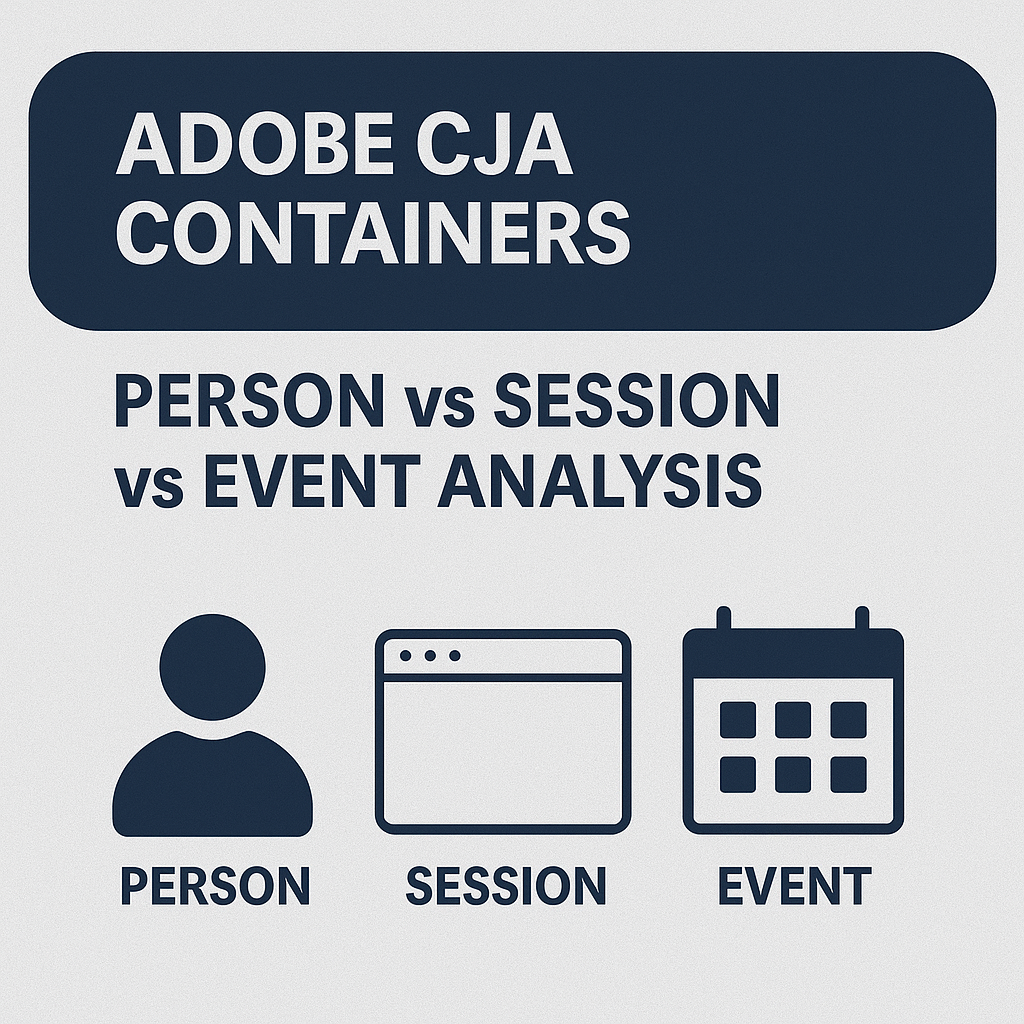Adobe Customer Journey Analytics (CJA) containers are fundamental building blocks that shape how your customer data is analyzed and understood. These containers – Person, Session, and Event – each serve as distinct lenses through which you can view and interpret customer interactions with your digital properties. By understanding the unique capabilities and use cases of each container type, businesses can unlock deeper insights into customer behavior and make more informed decisions about their digital experience strategies.
Table of contents
Introduction to CJA Containers
Adobe Customer Journey Analytics (CJA) offers three fundamental containers for data analysis: Person, Session, and Event. These containers determine how your data is organized and analyzed, ultimately affecting how you understand your customer journey. Each container serves a specific purpose and provides different insights into customer behavior.
Person Container Analysis
What is a Person Container?
The Person container represents the broadest scope in CJA, encompassing all interactions from a single customer across multiple sessions and timeframes. It’s the highest-level container that provides a comprehensive view of the customer journey.
Key Features
- Persistent visitor identification across devices and channels
- Lifetime value calculations
- Cross-session behavior analysis
- Long-term pattern recognition
Use Cases
- Customer lifetime value analysis
- Cross-device journey mapping
- Purchase frequency patterns
- Brand loyalty assessment
Session Container Analysis
What is a Session Container?
A session container represents a single visit or interaction period within your digital property. It typically begins when a user starts their interaction and ends after a period of inactivity (usually 30 minutes, but customizable).
Key Features
- Time-bound interaction groups
- Sequential interaction analysis
- Entry and exit point tracking
- Session-specific metrics
Use Cases
- Conversion path analysis
- Content effectiveness measurement
- Campaign performance evaluation
- User flow optimization
Event Container Analysis
What is an Event Container?
The Event container represents the most granular level of analysis, focusing on individual actions or interactions within a session. Each click, page view, or action is treated as a distinct event.
Key Features
- Individual interaction tracking
- Granular behavioral analysis
- Specific action attribution
- Micro-conversion tracking
Use Cases
- Click-path analysis
- Feature adoption tracking
- Error tracking and debugging
- Individual interaction performance
Choosing the Right Container
Factors to Consider
1. Analysis Objectives
- What insights are you trying to gain?
- What business questions are you trying to answer?
2. Data Granularity
- How detailed does your analysis need to be?
- What level of aggregation makes sense for your use case?
3. Attribution Requirements
- How do you want to attribute success events?
- What’s your attribution window?
Customer Journey Analytics Container Selection Guide
Choose Person Container when:
- Analyzing long-term customer behavior
- Calculating lifetime metrics
- Studying cross-device journeys
- Evaluating overall customer value
Choose Session Container when:
- Analyzing single-visit behaviors
- Evaluating campaign effectiveness
- Studying conversion paths
- Measuring engagement depth
Choose Event Container when:
- Tracking specific interactions
- Debugging user experiences
- Measuring micro-conversions
- Analyzing detailed user flows
Best Practices and Use Cases
Person Container Best Practices
- Implement robust visitor identification
- Use consistent customer IDs across channels
- Consider privacy and data retention policies
- Set appropriate lookback windows
Session Container Best Practices
- Define session timeouts appropriately
- Consider mobile vs desktop behaviors
- Account for cross-channel sessions
- Monitor session quality metrics
Event Container Best Practices
- Implement consistent event tracking
- Use clear naming conventions
- Define event hierarchies
- Monitor event quality
FAQs
Q: Can I use multiple containers in a single analysis?
A: Yes, CJA allows you to combine different container levels for comprehensive analysis. This is particularly useful when you need to understand both micro and macro behaviors.
Q: How do containers affect attribution?
A: Different containers provide different attribution scopes. Person containers allow for cross-session attribution, while session containers limit attribution to single visits, and event containers focus on individual interactions.
Q: How do privacy regulations affect container usage?
A: Privacy regulations like GDPR and CCPA impact how you can collect and retain data across containers. Person containers typically require more careful privacy consideration due to their persistent nature.
Conclusion
Understanding and effectively using CJA containers is crucial for accurate customer journey analysis. Each container type serves specific analytical purposes and provides unique insights. By choosing the right container for your analysis needs and following best practices, you can unlock deeper insights into your customer behavior and optimize their journey accordingly. Interview Techies is one stop platform for adobe solutions & interview questions.
Related Topics
- Adobe Analytics Workspace
- Cross-Device Analytics
- Attribution Models
- Customer Journey Mapping
- Data Collection Strategies
